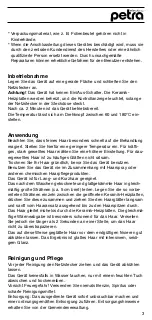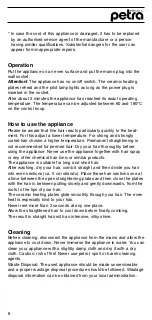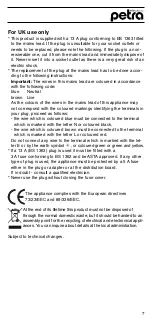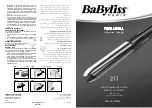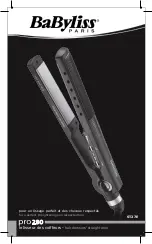
·
In case the cord of this appliance is damaged, it has to be replaced
by an authorised service agent of the manufacturer or a person
having similar qualifications. Substantial dangers for the user can
appear from inappropriate repairs.
Operation
Put the appliance on an even surface and put the mains plug into the
wall socket.
Attention!
The appliance has no on/off switch. The ceramic heating
plates reheat and the pilot lamp lights as long as the power plug is
inserted in the socket.
After about 2 minutes the appliance has reached its exact operating
temperature. The temperature can be adjusted between 60 and 180°C
on the control knop.
How to use the appliance
Please be aware that fine hair reacts particularly quickly to the treat-
ment. For this adjust a lower temperature. For strong and strongly
curled hair choose a higher temperature. Permanent straightening is
not recommended for permed hair. Dry your hair thoroughly before
using the appliance. Never use the appliance together with hair spray
or any other chemical hair tonic or similar products.
The appliance is suitable for long and short hair.
After washing, dry your hair, comb it straight and then divide you hair
into even sections (ca. 5 cm strands). Place these hair sections one at
a time between the open straightening plates and then close the plates
with the hair in between pulling slowly and gently downwards, from the
roots to the tips of your hair.
The ceramic heating plates glide smoothly through your hair. The even
heat is especially kind to your hair.
Never rest more than 2 seconds at any one place.
Allow the straightened hair to cool down before finally combing.
The result is straight hair with an intensive, silky shine.
Cleaning
Before cleaning, disconnect the appliance from the mains and allow the
appliance to cool down. Never immerse the appliance in water. You can
clean your appliance with a slightly damp cloth and dry it with a dry
cloth. Caution: risk of fire! Never use petrol, spirit or harsh cleaning
agents.
Waste Disposal: The used appliance should be made unserviceable
and a proper wastage disposal procedure should be followed. Wastage
disposal information can be obtained from your local administration.
6



